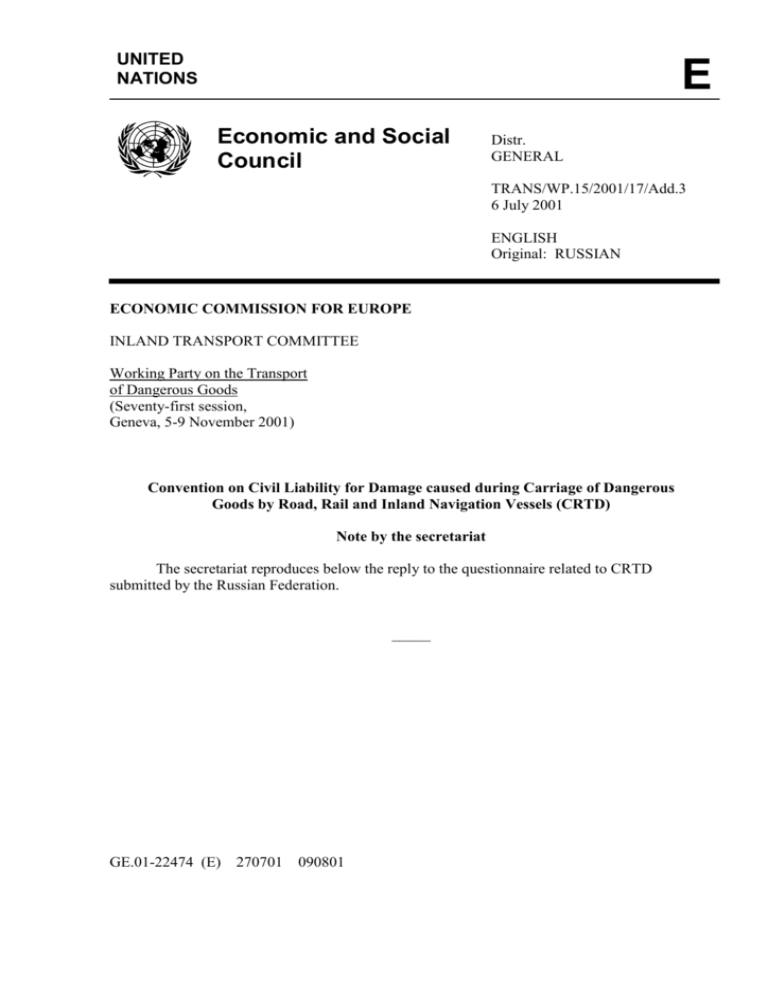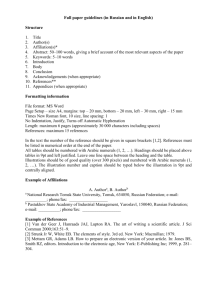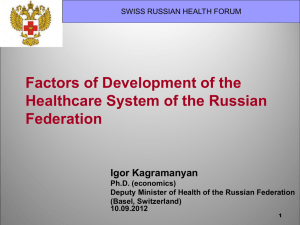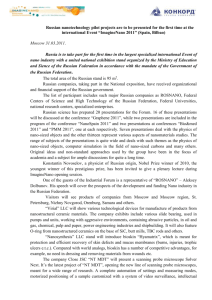Convention on Civil Liability for Damage caused during
advertisement

UNITED NATIONS E Economic and Social Council Distr. GENERAL TRANS/WP.15/2001/17/Add.3 6 July 2001 ENGLISH Original: RUSSIAN ECONOMIC COMMISSION FOR EUROPE INLAND TRANSPORT COMMITTEE Working Party on the Transport of Dangerous Goods (Seventy-first session, Geneva, 5-9 November 2001) Convention on Civil Liability for Damage caused during Carriage of Dangerous Goods by Road, Rail and Inland Navigation Vessels (CRTD) Note by the secretariat The secretariat reproduces below the reply to the questionnaire related to CRTD submitted by the Russian Federation. _____ GE.01-22474 (E) 270701 090801 TRANS/WP.15/2001/17/Add.3 page 2 1. Reply submitted by the Russian Federation Questions 1 and 6: With regard to carriage by rail Under article 1079, paragraph 1, of the Civil Code of the Russian Federation, the use of transport vehicles is classified as an activity posing a heightened danger to bystanders. The said article establishes the liability of legal entities and individuals for harm caused by activities constituting a heightened danger to bystanders. Legal entities and individuals whose activities involve heightened danger to bystanders (in particular, with the use of transport vehicles) are obliged to make compensation for harm caused by the source of such heightened danger, unless they are able to prove that the harm arose as a consequence of force majeure or by design of the injured party. In addition, under the general provisions of article 1064 of the Civil Code, compensation for harm must be made in full. Compensation for harm is made either in kind (an article of the same kind and quality is provided, damage to an article is made good, etc.) or in the form of reimbursement for damages attributable both to actual losses and to lost profit (article 15, paragraph 2, of the Civil Code). Similarly, pursuant to article 86 of the Protection of the Natural Environment Act (Act No. 2060-1 of the Russian Federation of 19 December 1991), enterprises, establishments, organizations and citizens causing harm to the environment or to the health and property of citizens through pollution of the natural environment, the damaging or destruction of natural environmental systems and other environmental offences are obliged to make full compensation for the harm in accordance with the law of the Russian Federation. Accordingly, the rules of the domestic legislation of the Russian Federation governing issues of civil liability differ substantially from the provisions of article 9 of the Convention, which establishes limited liability for carriers, which, in your view, is one of the reasons why the Russian Federation has not signed the Convention. Among other such reasons we may also cite discrepancies between the Convention and the civil legislation of the Russian Federation relating to statutes of limitations. In addition, article 1, paragraph 9, of the Convention, in elaborating on the term “dangerous goods”, refers only to ADR documents relating to carriage by road. Specific RID and SMGS documents apply to carriage by rail and these differ from ADR in their lists of dangerous goods. TRANS/WP.15/2001/17/Add.3 page 3 Question 1: With regard to carriage by inland navigation On the inland waterways of the Russian Federation no limit is set on liability for losses in the carriage of dangerous goods. CRTD does not take full account of the specific aspects of navigation on international inland waterways. With regard to carriage by road The Convention provides for the liability of the carrier and makes no provision for the liability of the consignor (or consignee). Question 2: With regard to carriage by rail No limits are set on civil liability by the law of the Russian Federation. In addition, when calculating the extent of actual losses due to pollution of the natural environment, officially approved rates and methods are used and, where these are not available, the amount of harm for which compensation is to be made is determined on the basis of actual expenditure on measures to restore the natural environment, taking into account any damages suffered, including lost profits (article 87 of the Protection of the Natural Environment Act). Parties causing harm may also be obliged by law or by a treaty to pay compensation to the injured party over and above mere restitution of the harm (article 1085 of the Civil Code). The limits of liability established by the Convention do not vary in accordance with the type of transport. In certain cases these limits may be lower than those calculated in the Russian Federation with the use of officially approved methods and rates. With regard to carriage by inland navigation The Russian Federation believes that the limits of liability are too high. Applying these limits of liability will mean that unjustifiably high premiums will be paid to insurance companies. With regard to carriage by road The limit of a road carrier’s liability established in article 9 of the Convention for any one incident in the carriage of dangerous goods by road at 18 million SDRs (US$ 23 million) seems excessively high and unrealistic. At the same time, the Convention sets no limit on the carrier’s liability, not even at this level, in the event of his careless action. TRANS/WP.15/2001/17/Add.3 page 4 Question 3: With regard to carriage by rail No statistics are available on the average level of damage caused by accidents occurring in the carriage of dangerous goods by rail. With regard to carriage by inland navigation Based on 1999 results (accident of the Nefterudovoz 7 barge) total actual losses amounted to 2.17 million ecus. With regard to carriage by road No statistics are available on the average level of damage during the transport of dangerous goods by road. Question 4: With regard to carriage by rail At the current time, civil liability insurance is optional under the civil legislation of the Russian Federation (article 927 and article 931, paragraph 1, of the Civil Code). Civil liability insurance may only be compulsory in cases where persons specified by law are obliged in the capacity of the insured to insure their civil liability before third parties (article 927, paragraph 2, of the Civil Code). At the same time, the Convention obliges the carrier to cover his liability by insurance or by some other form of financial security (article 13, paragraph 1, of the Convention). Accordingly, for the Russian Federation to accede to the Convention, it would be advisable to establish a rule in the Convention under which the carrier would only be obliged to take out civil liability insurance in cases directly stipulated by his domestic law but that he would be entitled to cover his civil liability with optional third party insurance at his own expense or at the expense of other interested parties. With regard to carriage by inland navigation The most acceptable option to us would be to abandon compulsory insurance. There are no mutual insurance associations in the Russian Federation and a portion of the profits from insurance premiums will be lost in tax payments. TRANS/WP.15/2001/17/Add.3 page 5 Question 5: With regard to carriage by rail The introduction, in accordance with the Convention, of compulsory insurance (article 13) or of a limited fund (article 11) is nothing more or less than the crediting of possible disbursements for damage to goods during carriage. The application of such a mechanism in the Russian Federation for rail transport will inevitably cause an increase in freight tariffs, running counter to the declared State policy for an across-the-board reduction in the transport component of the cost of goods and services. With regard to carriage by inland navigation The requirement for a compulsory insurance certificate creates no difficulties for insurance institutions to insure or reinsure the limits of liability provided for in the Convention. Question 6: With regard to carriage by inland navigation In the conditions of the Russian Federation, when the actual losses from accidents on inland waterways involving vessels carrying dangerous goods are insignificant and the insurance premiums have been paid regularly, the level of the limitation of liability should not exceed 1 million SDRs for risks of death or bodily injury and 500,000 SDRs for other risks. -----





